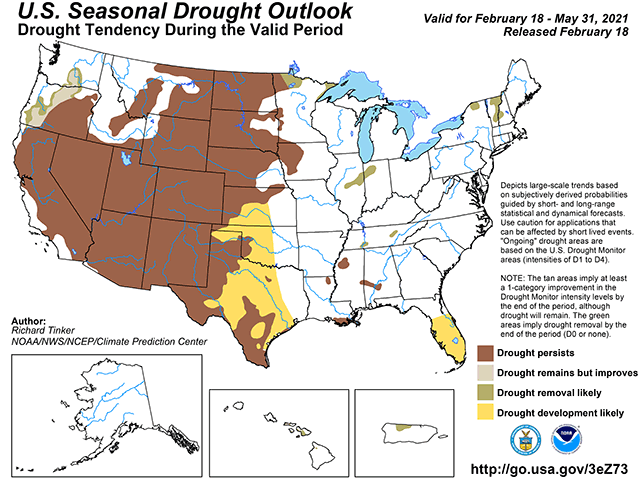La Nina Dryness Forecast for Spring
Continued Plains, Western Midwest Drought Expected
OMAHA (DTN) -- Scientists with the National Oceanic and Atmospheric Administration (NOAA) and the USDA Midwest Climate Hub have drought in focus for much of the central region of the United States through the spring season. The NOAA Climate Prediction Center seasonal drought outlook, which runs through the end of May, calls for drought to remain in western Iowa, and to either remain or develop over all but the southeastern portion of the Plains.
Some portions of the central region have heavy snow cover. "Lincoln, Nebraska, has more snow than Fort Collins, Colorado, which is unusual," said Colorado Assistant State Climatologist Becky Bolinger. However, the moisture content in the snow is quite low.
"There's not a lot of moisture in the snow that's on the ground," Bolinger said. "The Platte River Basin is below average. The Missouri River Basin is below average."
Winter wheat in the central region, especially in the Plains, has been stressed and damaged by both drought and bitter cold. Temperatures in the central region were as much as 40 degrees Fahrenheit below normal during mid-February. The combination is harsh and intensified by low snow cover ahead of the onset of the cold wave.
P[L1] D[0x0] M[300x250] OOP[F] ADUNIT[] T[]
"The extreme cold combined with little snow cover is threatening to wheat," Bolinger said. "We could see widespread damage; it's really hard to separate drought damage from cold weather damage."
In addition to the adverse drought forecast impact on wheat, soil moisture for row crops and pastures is lacking ahead of spring planting and the green-up phase.
"There is a lack of moisture in the deep soil profiles from last year's (2020) drought," Bolinger said. "We are also likely to have a shortage of adequate pasture and forage in the drought-hit areas."
Fire danger is also high going into spring due to a lack of moisture. "There is a high fire danger on the Plains this spring," Bolinger noted.
Such a forecast is no surprise. "Large fire years coincide with drought years. We would expect that areas with low snowpack have a risk of large wildfires this season. There is a bigger risk if there's an early melting of the snowpack" she said.
Meanwhile, thousands of miles west of the central U.S., a La Nina Pacific Ocean temperature and atmosphere event is expected to stay around through the growing season. La Nina began during the 2020 summer with a very dry effect on the U.S. corn and soybean crops. Forecast models call for La Nina to fade briefly during the spring, but to return during the summer. "This has happened before, where we get a double-dip of the La Nina event," said NOAA Regional Manager Doug Kluck. The La Nina influence is key to the forecast projections.
In contrast to the Western Corn Belt, spring forecast precipitation is higher in the Eastern Corn Belt. The risk of flooding is also higher in the mid-Mississippi and Ohio River valleys.
"Those areas are more likely to see flooding with higher stream flows, not as dry soils and increased precipitation," Bolinger said.
Bryce Anderson can be reached at bryce.anderson@dtn.com
Follow him on Twitter @BAndersonDTN
(c) Copyright 2021 DTN, LLC. All rights reserved.




